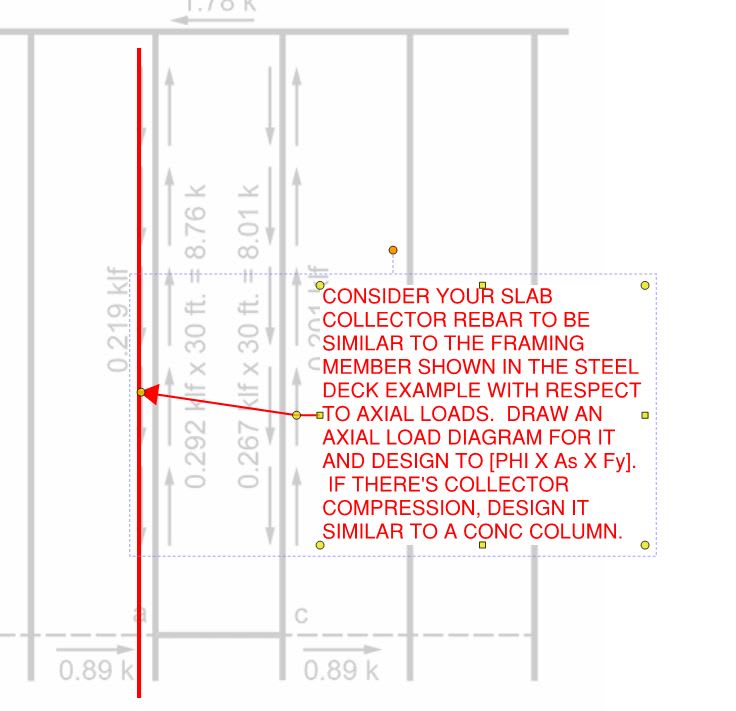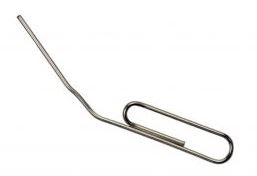I'm trying to design the required reinforcing steel around a cast in place diaphragm opening. I used the reinforced concrete design handbook, SP-17(14) for the chord steel, it does not tell you how to design the collector steel at the opening. The only example I've been able to find is this one for a steel deck. ( ) Lets assume the diaphragm in the link is concrete and the forces are the same; am i designing the collector steel at the opening for the 8.76k reaction?
Navigation
Install the app
How to install the app on iOS
Follow along with the video below to see how to install our site as a web app on your home screen.
Note: This feature may not be available in some browsers.
More options
Style variation
-
Congratulations MintJulep on being selected by the Eng-Tips community for having the most helpful posts in the forums last week. Way to Go!
You are using an out of date browser. It may not display this or other websites correctly.
You should upgrade or use an alternative browser.
You should upgrade or use an alternative browser.
Diaphragm Opening 2
- Thread starter Bobbybob
- Start date
- Status
- Not open for further replies.
Have you checked out the NEHRP design guide on diaphragms?
HELP! I'd like your help with a thread that I was forced to move to the business issues section where it will surely be seen by next to nobody that matters to me:
HELP! I'd like your help with a thread that I was forced to move to the business issues section where it will surely be seen by next to nobody that matters to me:
- Thread starter
- #3
Yes, nherp seismic design technical brief no. 3, second edition. I have searched google for everything i could find. I'm just not getting it.
Ok. Let's start general and then get specific as required. The sketch below shows the general process.
How to do this in CIP slabs is a bit nebulous for a few reasons:
1) There are multiple ways to do it in CIP decks.
2) Until recently, we didn't really worry about this in CIP decks as they're pretty robust with respect to these types of actions.
3) The high seismic detailing discussed in the NEHRP doc is often poorly received by construction teams in jurisdictions where seismic is less of a concern. If it's me and it's not high seismic, I'll bend over backwards to tell a story that doesn't require ties around the collector bars.
Is your situation high seismic or closer to the conventional end of the spectrum?

HELP! I'd like your help with a thread that I was forced to move to the business issues section where it will surely be seen by next to nobody that matters to me:
How to do this in CIP slabs is a bit nebulous for a few reasons:
1) There are multiple ways to do it in CIP decks.
2) Until recently, we didn't really worry about this in CIP decks as they're pretty robust with respect to these types of actions.
3) The high seismic detailing discussed in the NEHRP doc is often poorly received by construction teams in jurisdictions where seismic is less of a concern. If it's me and it's not high seismic, I'll bend over backwards to tell a story that doesn't require ties around the collector bars.
Is your situation high seismic or closer to the conventional end of the spectrum?

HELP! I'd like your help with a thread that I was forced to move to the business issues section where it will surely be seen by next to nobody that matters to me:
Probably the most complete design example I've seen of a diaphragm is in the 1991 edition of '246 Solved Structural Engineering Problems', by Buckner. (Seismic problem #11.)
The applicable codes are certainly dated.....but the logic is about the best I've seen.
The applicable codes are certainly dated.....but the logic is about the best I've seen.
- Thread starter
- #7
Seismic is category B. Based on that example the collector is taking the 0.219k/ft * 120ft = 26.28k/(.9*60ksi) = 0.48in2 of reinforcement steel? I don't know why but it seems excessive to me, then again i dont have any experience with this...
WARose and Edub24; Do those books have examples with openings in the diaphragms?
WARose and Edub24; Do those books have examples with openings in the diaphragms?
-
2
- #8
Bobbybo said:... 0.48in2 of reinforcement steel? I don't know why but it seems excessive to me...
That's like 2-#5 with 1/3 held in reserve. What were you hoping for, a rolled out paperclip?

HELP! I'd like your help with a thread that I was forced to move to the business issues section where it will surely be seen by next to nobody that matters to me:
Although you're right, I believe that you've grossly overestimated the net tension.
I highly recommend drawing the axial force diagram for the collector, considering what's gong on on both sides of the collector, as I recommended in my second post. If you haven't done this already, I suspect that it will be a worthwhile exercise. And, if you post the result, we can probably get you straightened out on this.
HELP! I'd like your help with a thread that I was forced to move to the business issues section where it will surely be seen by next to nobody that matters to me:
I highly recommend drawing the axial force diagram for the collector, considering what's gong on on both sides of the collector, as I recommended in my second post. If you haven't done this already, I suspect that it will be a worthwhile exercise. And, if you post the result, we can probably get you straightened out on this.
HELP! I'd like your help with a thread that I was forced to move to the business issues section where it will surely be seen by next to nobody that matters to me:
Bobbybob said:Do those books have examples with openings in the diaphragms?
Yup they both do.
Bobbybob said:the collector is taking the 0.219k/ft * 120ft
You have 120 foot long opening...That is quite the floor opening. Be sure to check for horizontal irregularities. Edit: This is the conservative method for determining the force in a collector. There are other methods that take into account the location of the opening.
- Thread starter
- #12
OK, here is my diagram. Is this right?
I had to attach it as a file.
I had to attach it as a file.
- Thread starter
- #13
- Status
- Not open for further replies.
Similar threads
- Replies
- 3
- Views
- 2K
- Replies
- 23
- Views
- 3K
- Replies
- 15
- Views
- 10K
- Replies
- 11
- Views
- 5K
- Replies
- 4
- Views
- 809
